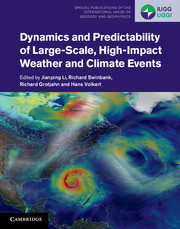Book contents
- Dynamics and Predictability of Large-Scale, High-Impact Weather and Climate Events
- Special publications of the International Union of Geodesy and Geophysics Series
- Dynamics and Predictability of Large-Scale High-Impact Weather and Climate Events
- Copyright page
- Contents
- Preface
- Frontispiece
- Book part
- Contributors
- Part I Diagnostics and prediction of high-impact weather
- Part II High-impact weather in mid latitudes
- Part III Tropical cyclones
- Part IV Heat waves and cold-air outbreaks
- 15 European heat waves: the effect of soil moisture, vegetation, and land use
- 16 Western North American extreme heat, associated large-scale synoptic-dynamics, and performance by a climate model
- 17 Decadal to interdecadal variations of northern China heat wave frequency: impact of the Tibetan Plateau snow cover
- 18 Global warming targets and heat wave risk
- 19 Cold-air outbreaks over East Asia associated with blocking highs: mechanisms and their interaction with the polar stratosphere
- Part V Ocean connections
- Part VI Asian monsoons
- Index
- References
19 - Cold-air outbreaks over East Asia associated with blocking highs: mechanisms and their interaction with the polar stratosphere
from Part IV - Heat waves and cold-air outbreaks
Published online by Cambridge University Press: 05 March 2016
- Dynamics and Predictability of Large-Scale, High-Impact Weather and Climate Events
- Special publications of the International Union of Geodesy and Geophysics Series
- Dynamics and Predictability of Large-Scale High-Impact Weather and Climate Events
- Copyright page
- Contents
- Preface
- Frontispiece
- Book part
- Contributors
- Part I Diagnostics and prediction of high-impact weather
- Part II High-impact weather in mid latitudes
- Part III Tropical cyclones
- Part IV Heat waves and cold-air outbreaks
- 15 European heat waves: the effect of soil moisture, vegetation, and land use
- 16 Western North American extreme heat, associated large-scale synoptic-dynamics, and performance by a climate model
- 17 Decadal to interdecadal variations of northern China heat wave frequency: impact of the Tibetan Plateau snow cover
- 18 Global warming targets and heat wave risk
- 19 Cold-air outbreaks over East Asia associated with blocking highs: mechanisms and their interaction with the polar stratosphere
- Part V Ocean connections
- Part VI Asian monsoons
- Index
- References
- Type
- Chapter
- Information
- Publisher: Cambridge University PressPrint publication year: 2016
References
- 6
- Cited by



